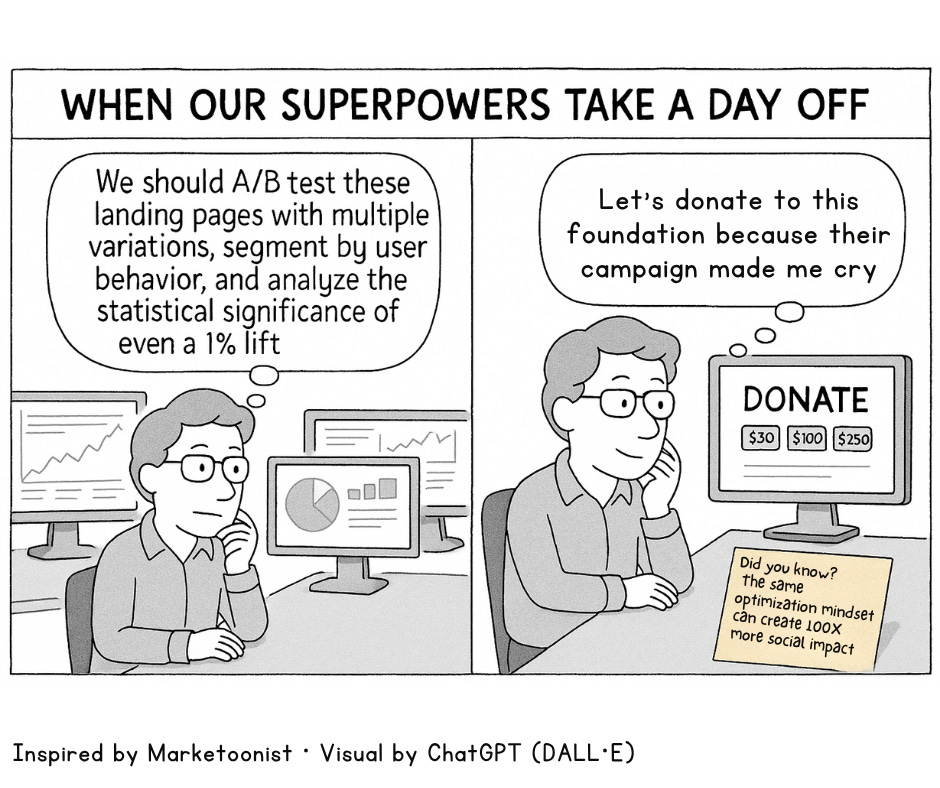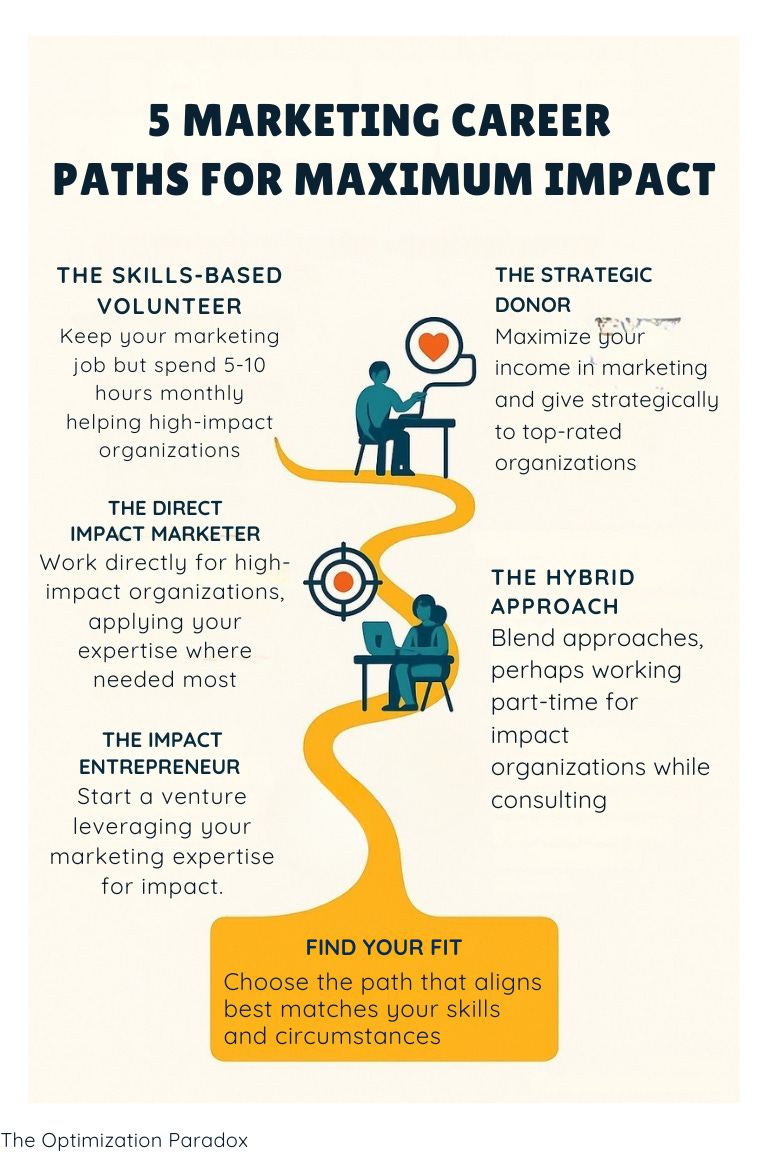The Optimization Paradox: Why Marketers Test Button Colors but Randomly Choose Charities
A Fresh POV for This Giving Season

Imagine this.
Your team has just discovered something remarkable.
Campaign A delivers 100X more conversions than Campaign B with the exact same budget.
The room erupts.
“Shift the budget immediately.”
“Scale this up now.”
“This is why we test everything.”
Everyone nods in agreement. It’s Marketing 101.
And if someone suggested, “Let’s keep running Campaign B because I really like the copy we wrote…”?
They’d be laughed out of the room. Maybe even out of the profession.
Because that’s not how good marketers make decisions.
But later that same day, when choosing which charity should receive the company’s annual donation…
The dynamic completely changes.
“Let’s donate to this foundation because their campaign made me cry.”
“This cause just feels right.”
“Supporting this charity will look amazing in our CSR report.”
“My neighbor’s on their board, and it would mean a lot to them.”
The same brilliant minds that instantly recognized a 100X performance gap now use entirely different criteria.
And here’s the truly mind-blowing part:
The same 100X performance gaps exist in charitable giving.
Some interventions literally save 100 times more lives per dollar than others.
But unlike marketing metrics, these numbers aren’t in our dashboards.
We don’t see them in our morning reports.
No one presents them in quarterly reviews.
This is the Optimization Paradox: our professional optimization instinct suddenly goes quiet exactly when it could have its greatest human impact.
Not because we don’t care.
But because we simply haven’t connected these worlds before.
Until now.
The 100X Gap You Never Hear About
Think about discovering a marketing channel with 100X better ROAS that your competitors haven’t noticed yet. According to research from Oxford and Exeter Universities published in Judgment and Decision Making, that’s essentially what exists in the charitable sector.
Their study found that experts estimate the best charities are 100 times more effective than average ones. Not twice as good. Not ten times better. One hundred times more effective.
Yet the same research found that most donors think the difference is only 1.5 to 2 times — a massive perception gap.
Most of us assume charities are roughly equivalent in their impact. Feed the hungry here, build a school there. The data tells a different story.
What if You Could Help 1,000 People Instead of One?
For $50,000, you could:
Train ONE guide dog for ONE blind person
OR prevent 1,000 people from going blind through trachoma surgeries ($50 each)
Both are worthy causes helping real people. Yet the same budget yields a thousandfold difference in results. According to Toby Ord’s 2013 analysis of the Disease Control Priorities Project, some health interventions work up to 15,000X more effectively than others.
When researchers showed donors this data, donations to effective charities grew by 55.6%. Knowledge changes behavior.
Why the Optimization Paradox Persists
In business, a product 100X worse than competitors would die fast. Competition drives efficiency. The nonprofit sector works under different rules.
In the charitable world, there’s no built-in mechanism driving resources toward the most effective organizations. Donors rarely fund charities based on effectiveness data. Emotional appeals typically win over impact metrics.
As a result, large effectiveness gaps persist indefinitely. According to GiveWell’s 2025 impact estimates, their top charities save a life for about $5,000. Other well-intended interventions cost $500,000+ to save one life.
Marketing Skills in Action: Transformation Stories
For Rob Mather, the trigger moment came in 2003. He watched a documentary about a Tanzanian girl with burns. Most viewers felt sad and moved on. But Mather, with his business background, saw a chance to apply optimization thinking.
He did not donate emotionally. He organized a swimming fundraiser with 150 people across 73 locations in 12 countries. Then he founded the Against Malaria Foundation (AMF).
Today, AMF tracks every insecticide-treated mosquito net with GPS, captures photos from recipients, and publishes all data online. According to The Life You Can Save (2025), the result has been remarkable: 36.5 million nets distributed, protecting 66 million people, preventing more than 24,300 deaths.
“About $100 million of our funding comes from people who evaluated us like a business investment,” Mather explains.
Johnstuart Winchell changed after a McGill University philosophy class. Reading philosopher Peter Singer, whose work on effective altruism has influenced thousands, one question stuck with him:
“If effectiveness matters for marketing campaigns, why not for saving lives?”
This question followed him through his career at Boston Consulting Group and later at Google, where he helped Canada’s largest advertisers optimize YouTube campaigns.
Eventually he took action. He founded Good Impressions, a marketing agency serving high impact organizations.
For Legal Impact for Chickens, his team ran targeted Meta ads within 5 miles of factory farms asking workers to report animal cruelty. These ads successfully recruited whistleblowers at a fraction of the cost of traditional investigation methods.
For AI safety courses, his campaigns achieved 14 to 45X ROI.
These examples show how marketing skills can overcome the Optimization Paradox.
Familiar Skills, New Applications
The beauty of this approach is that we already have the skills. Moving from optimizing campaigns to optimizing humanitarian impact works with frameworks we use every day:
Marginal Thinking
Marketing: “Where will my next dollar drive the highest ROI?”
Impact: “Where will my next dollar save the most lives?”
Expected Value
Marketing: “10% chance of 100 conversions equals 10 conversions in expectation”
Impact: “10% chance of saving 100 lives equals 10 lives in expectation”
A/B Testing
Marketing: Test messages, visuals, CTAs
Impact: Test appeals, programs, distribution methods
Charity:Water demonstrates this principle. According to reporting by The Drum (February 2019), when they partnered with Persado to apply A/B testing to Facebook campaigns, community-focused messages outperformed history-focused ones by 227%.
When they tested increased email frequency from monthly to twice weekly, donations increased by about $800,000.
Same skills. Different metrics. Big impact.
I spent seven years in marketing, investigating how to channel these skills toward greater impact. Here’s what I learned:
1. The Skills Based Volunteer
Keep your marketing job but spend 5 to 10 hours monthly helping high impact organizations.
Example: Igor Scaldini volunteers his skills to ClearerThinking.org while maintaining his corporate role.
“I create more impact in 5 hours helping effective organizations than in 500 hours helping average ones,” he says.
Ideal for: Marketing professionals who want to maintain their current career trajectory while creating significant impact through targeted skills.
2. The Strategic Donor
Maximize your income in marketing and give strategically to top rated organizations.
For high earners in marketing or tech, donating 10–20% of income to the most effective charities often creates more impact than working directly at a nonprofit. A marketing executive earning $300,000 who donates $60,000 annually can fund multiple full-time charity workers or interventions that help thousands, while maintaining their career trajectory and influence in their industry.
Ideal for: High-earning marketers who can create more impact through strategic giving than through direct work.
3. The Direct Impact Marketer
Work directly for high impact organizations, applying your marketing expertise where needed most.
Example: Tess Newton Palmer now serves as Director of Marketing at the Centre for Effective Altruism after 15+ years building brands.
Ideal for: Marketers seeking to align their full-time work with their values and directly apply their skills to important causes.
4. The Impact Entrepreneur
Start a venture leveraging your marketing expertise for impact.
Example: Winchell’s Good Impressions agency serves 60+ nonprofits working on pressing global problems.
Ideal for: Entrepreneurial marketers who want to create systems and platforms that scale solutions to important problems.
5. The Hybrid Approach
Blend approaches, perhaps working part time for impact organizations while consulting.
Example: Sarah Gokhale combined her philosophy PhD with advertising agency experience to work with multiple effective organizations.
Ideal for: Marketers seeking flexibility or testing different paths before committing to a single approach.
Three Steps to Find Your Perfect Fit
Step 1: Match Your Marketing Skills to Impact Areas
Finding your impact sweet spot starts with honest self-assessment. Which marketing skills have you truly mastered?
Content creators excel at advocacy campaigns for neglected issues like factory farming or AI safety.
Analytics experts shine in impact measurement and program evaluation.
Relationship builders make natural fundraisers and coalition creators.
Brand strategists help technical organizations explain complex ideas clearly.
Social media specialists build awareness for evidence-based solutions.
Growth marketers help scale proven interventions to reach more people.
The key question: Where do your specific marketing strengths create the most leverage for important problems?
Step 2: Try Small Experiments Before Big Leaps
Career changes feel risky. Smart marketers test before investing fully.
Shadow experiment: Spend a day with someone in your target impact role. Ask about their daily work. Learn about their challenges firsthand.
Project experiment: Volunteer for a small, defined project with a high-impact group. Commit just 5–10 hours to test your fit. Notice what energizes you. Pay attention to what drains you.
Giving experiment: Try giving 1–3% of your income to evidence-based organizations like GiveWell top picks. Track how this changes your thinking about impact.
Content experiment: Create something about big problems that match your expertise. Share with relevant communities.
Step 3: Time Your Impact Journey Right
Your career stage matters when planning your impact path.
Early career (first 5 years): Focus mainly on building transferable skills. Accumulate career capital. Choose roles where you learn rapidly. Immediate impact might seem low. Your future impact depends on the foundation you build now.
Mid-career (5–10 years): Begin incorporating impact through side projects. Continue building expertise. Consider adjacent roles that maintain your skills. Look for positions that increase your impact gradually.
Peak career (10+ years): Leverage your established expertise and network. Your unique skills create rare opportunities. This stage offers maximum potential for change.
Sometimes the highest-impact path involves building substantial career capital before transitioning to direct impact work.
The most important thing is sustainability. Choose paths you can maintain for decades. Avoid burnout-inducing options that last only months.
Addressing Common Concerns
“Impact measurement lacks accuracy.”
So does marketing attribution. Neither system provides perfect data. Yet we make significant decisions based on attribution models daily. Even imperfect impact measurements identify major trends and correlations between interventions. Some information beats none.
“I need financial stability.”
Many impact paths maintain or increase your income. According to industry salary surveys, nonprofit marketing positions offer competitive compensation, with senior roles typically ranging from $80,000-$120,000. This range is comparable to many corporate roles. Skills-based volunteering maintains your current income entirely. Financial security and impact can grow together.
“This approach feels too calculating.”
Data and emotion work together. They are not opponents. Analysis directs your empathy where it helps more people. Your emotional energy deserves maximum positive impact.
“I’m just one person. What difference will I make?”
Marketing is built on leverage and multiplier effects. So is impact. One marketer helping an organization increase donor conversion by 20% creates massive change. This could mean hundreds of thousands more dollars for life-saving interventions.
Your Career’s Most Meaningful Chapter
The Optimization Paradox represents an extraordinary opportunity for marketers.
Our skills — the ability to change minds and inspire action — are precisely what effective causes need most. By applying the strategic thinking we use daily to philanthropic decisions, we can 100X our impact.
As marketers, we’re uniquely positioned to bridge the gap between emotional appeal and measured results. We already speak both languages.
Whether you volunteer your skills, redirect your giving, or pivot your career entirely — the opportunities to create meaningful change exist right now. And our profession’s analytical toolkit makes us especially qualified to make the most of them.
If you enjoyed this piece, you’ll probably like my newsletter Big Marketing for Bigger Problems — where I explore how marketing and behavioral science can help tackle the world’s most burning problems.
Useful Resources
For guidance on impact-focused marketing careers, explore resources like High Impact Professionals, Probably Good, and 80,000 Hours — offering communities, career frameworks, and transition strategies for marketers seeking greater impact.
If you’re considering the strategic donor path, GiveWell and Giving What We Can identify evidence-based giving opportunities where your donations can save the most lives.


